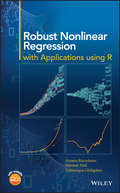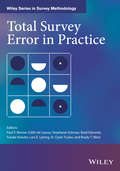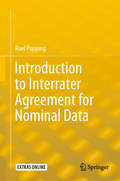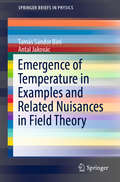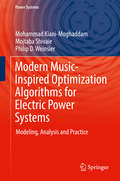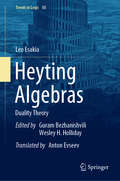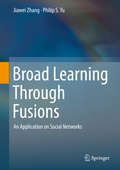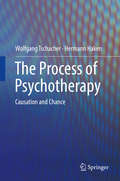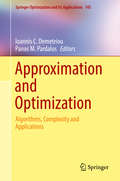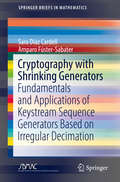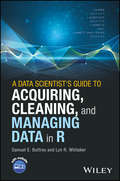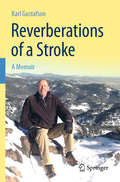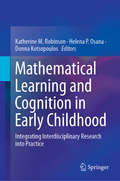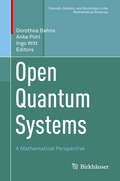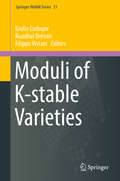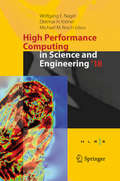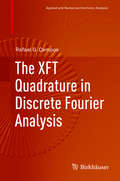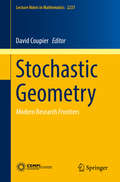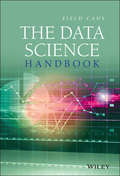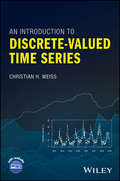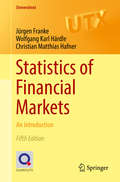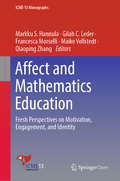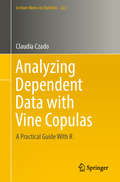- Table View
- List View
Robust Nonlinear Regression: with Applications using R
by Hossein Riazoshams Habshah Midi Gebrenegus GhilagaberThe first book to discuss robust aspects of nonlinear regression—with applications using R software Robust Nonlinear Regression: with Applications using R covers a variety of theories and applications of nonlinear robust regression. It discusses both parts of the classic and robust aspects of nonlinear regression and focuses on outlier effects. It develops new methods in robust nonlinear regression and implements a set of objects and functions in S-language under SPLUS and R software. The software covers a wide range of robust nonlinear fitting and inferences, and is designed to provide facilities for computer users to define their own nonlinear models as an object, and fit models using classic and robust methods as well as detect outliers. The implemented objects and functions can be applied by practitioners as well as researchers. The book offers comprehensive coverage of the subject in 9 chapters: Theories of Nonlinear Regression and Inference; Introduction to R; Optimization; Theories of Robust Nonlinear Methods; Robust and Classical Nonlinear Regression with Autocorrelated and Heteroscedastic errors; Outlier Detection; R Packages in Nonlinear Regression; A New R Package in Robust Nonlinear Regression; and Object Sets. The first comprehensive coverage of this field covers a variety of both theoretical and applied topics surrounding robust nonlinear regression Addresses some commonly mishandled aspects of modeling R packages for both classical and robust nonlinear regression are presented in detail in the book and on an accompanying website Robust Nonlinear Regression: with Applications using R is an ideal text for statisticians, biostatisticians, and statistical consultants, as well as advanced level students of statistics.
Total Survey Error in Practice: Improving Quality In The Era Of Big Data (Wiley Series in Survey Methodology)
by Paul P. Biemer Edith De Leeuw Stephanie Eckman Brad Edwards Frauke Kreuter Lars E. Lyberg N. Clyde Tucker Brady T. WestFeaturing a timely presentation of total survey error (TSE), this edited volume introduces valuable tools for understanding and improving survey data quality in the context of evolving large-scale data sets This book provides an overview of the TSE framework and current TSE research as related to survey design, data collection, estimation, and analysis. It recognizes that survey data affects many public policy and business decisions and thus focuses on the framework for understanding and improving survey data quality. The book also addresses issues with data quality in official statistics and in social, opinion, and market research as these fields continue to evolve, leading to larger and messier data sets. This perspective challenges survey organizations to find ways to collect and process data more efficiently without sacrificing quality. The volume consists of the most up-to-date research and reporting from over 70 contributors representing the best academics and researchers from a range of fields. The chapters are broken out into five main sections: The Concept of TSE and the TSE Paradigm, Implications for Survey Design, Data Collection and Data Processing Applications, Evaluation and Improvement, and Estimation and Analysis. Each chapter introduces and examines multiple error sources, such as sampling error, measurement error, and nonresponse error, which often offer the greatest risks to data quality, while also encouraging readers not to lose sight of the less commonly studied error sources, such as coverage error, processing error, and specification error. The book also notes the relationships between errors and the ways in which efforts to reduce one type can increase another, resulting in an estimate with larger total error. This book: • Features various error sources, and the complex relationships between them, in 25 high-quality chapters on the most up-to-date research in the field of TSE • Provides comprehensive reviews of the literature on error sources as well as data collection approaches and estimation methods to reduce their effects • Presents examples of recent international events that demonstrate the effects of data error, the importance of survey data quality, and the real-world issues that arise from these errors • Spans the four pillars of the total survey error paradigm (design, data collection, evaluation and analysis) to address key data quality issues in official statistics and survey research Total Survey Error in Practice is a reference for survey researchers and data scientists in research areas that include social science, public opinion, public policy, and business. It can also be used as a textbook or supplementary material for a graduate-level course in survey research methods.
Introduction to Interrater Agreement for Nominal Data (SpringerBriefs in Statistics)
by Roel PoppingThis introductory book enables researchers and students of all backgrounds to compute interrater agreements for nominal data. It presents an overview of available indices, requirements, and steps to be taken in a research project with regard to reliability, preceded by agreement. The book explains the importance of computing the interrater agreement and how to calculate the corresponding indices. Furthermore, it discusses current views on chance expected agreement and problems related to different research situations, so as to help the reader consider what must be taken into account in order to achieve a proper use of the indices.The book offers a practical guide for researchers, Ph.D. and master students, including those without any previous training in statistics (such as in sociology, psychology or medicine), as well as policymakers who have to make decisions based on research outcomes in which these types of indices are used.
Emergence of Temperature in Examples and Related Nuisances in Field Theory (SpringerBriefs in Physics)
by Antal Jakovác Tamás Sándor BiróField theory, relying on the concept of continuous space and time while confronted with the quantum physical nature of observable quantities, still has some fundamental challenges to face. One such challenge is to understand the emergence of complexity in the behavior of interacting elementary fields, including among other things nontrivial phase structures of elementary matter at high energy density or an atypical emergence of statistical properties, e.g., when an apparent temperature is proportional to a constant acceleration in a homogeneous gravitational field. Most modern textbooks on thermal field theory are mainly concerned with how the field theory formalism should be used if a finite temperature is given. In contrast, this short primer explores how the phenomenon of temperature emerges physically for elementary fields - inquiring about the underlying kinetic field theory and the way energy fluctuations and other noise should be handled - and it investigates whether and how this harmonizes with traditional field theory concepts like spectral evolution, the Keldysh formalism, and phase transitions.
Alice's Adventures in Wonderland: 150th Anniversary Edition (The\black Cat Ser.)
by Lewis CarrollCommemorating the 150th anniversary of one of the most beloved classics of children's literature, this illustrated edition presents Alice like you’ve never seen her before.In 1865, Charles Lutwidge Dodgson, an Oxford mathematician and Anglican deacon, published a story about a little girl who tumbles down a rabbit hole. Thus was the world first introduced to Alice and her pseudonymous creator, Lewis Carroll. This beautiful new edition of Alice’s Adventures in Wonderland features rarely seen illustrations by Salvador Dalí that illuminate the surreal yet curiously logical and mathematical realm into which Alice famously falls.In an informative and wide-ranging introduction, Carroll expert Mark Burstein discusses Dalí’s connections with Carroll, his treatment of the symbolic figure of Alice, and the mathematical nature of Wonderland. In addition, mathematician Thomas Banchoff reflects on the friendship he shared with Dalí and explores the mathematical undercurrents in Dalí’s work.
Alice's Adventures in Wonderland: 150th Anniversary Edition
by Lewis CarrollCommemorating the 150th anniversary of one of the most beloved classics of children's literature, this illustrated edition presents Alice like you’ve never seen her before.In 1865, Charles Lutwidge Dodgson, an Oxford mathematician and Anglican deacon, published a story about a little girl who tumbles down a rabbit hole. Thus was the world first introduced to Alice and her pseudonymous creator, Lewis Carroll. This beautiful new edition of Alice’s Adventures in Wonderland features rarely seen illustrations by Salvador Dalí that illuminate the surreal yet curiously logical and mathematical realm into which Alice famously falls.In an informative and wide-ranging introduction, Carroll expert Mark Burstein discusses Dalí’s connections with Carroll, his treatment of the symbolic figure of Alice, and the mathematical nature of Wonderland. In addition, mathematician Thomas Banchoff reflects on the friendship he shared with Dalí and explores the mathematical undercurrents in Dalí’s work.
Modern Music-Inspired Optimization Algorithms for Electric Power Systems: Modeling, Analysis and Practice (Power Systems)
by Mohammad Kiani-Moghaddam Mojtaba Shivaie Philip D. WeinsierIn today’s world, with an increase in the breadth and scope of real-world engineering optimization problems as well as with the advent of big data, improving the performance and efficiency of algorithms for solving such problems has become an indispensable need for specialists and researchers. In contrast to conventional books in the field that employ traditional single-stage computational, single-dimensional, and single-homogeneous optimization algorithms, this book addresses multiple newfound architectures for meta-heuristic music-inspired optimization algorithms. These proposed algorithms, with multi-stage computational, multi-dimensional, and multi-inhomogeneous structures, bring about a new direction in the architecture of meta-heuristic algorithms for solving complicated, real-world, large-scale, non-convex, non-smooth engineering optimization problems having a non-linear, mixed-integer nature with big data. The architectures of these new algorithms may also be appropriate for finding an optimal solution or a Pareto-optimal solution set with higher accuracy and speed in comparison to other optimization algorithms, when feasible regions of the solution space and/or dimensions of the optimization problem increase. This book, unlike conventional books on power systems problems that only consider simple and impractical models, deals with complicated, techno-economic, real-world, large-scale models of power systems operation and planning. Innovative applicable ideas in these models make this book a precious resource for specialists and researchers with a background in power systems operation and planning.Provides an understanding of the optimization problems and algorithms, particularly meta-heuristic optimization algorithms, found in fields such as engineering, economics, management, and operations research;Enhances existing architectures and develops innovative architectures for meta-heuristic music-inspired optimization algorithms in order to deal with complicated, real-world, large-scale, non-convex, non-smooth engineering optimization problems having a non-linear, mixed-integer nature with big data;Addresses innovative multi-level, techno-economic, real-world, large-scale, computational-logical frameworks for power systems operation and planning, and illustrates practical training on implementation of the frameworks using the meta-heuristic music-inspired optimization algorithms.
Heyting Algebras: Duality Theory (Trends in Logic #50)
by Leo EsakiaThis book presents an English translation of a classic Russian text on duality theoryfor Heyting algebras. Written by Georgian mathematician Leo Esakia, the text provedpopular among Russian-speaking logicians. This translation helps make the ideasaccessible to a wider audience and pays tribute to an influential mind in mathematicallogic. The book discusses the theory of Heyting algebras and closure algebras, aswell as the corresponding intuitionistic and modal logics. The author introduces thekey notion of a hybrid that “crossbreeds” topology (Stone spaces) and order (Kripkeframes), resulting in the structures now known as Esakia spaces. The main theoremsinclude a duality between the categories of closure algebras and of hybrids, and a dualitybetween the categories of Heyting algebras and of so-called strict hybrids.Esakia’s book was originally published in 1985. It was the first of a planned two-volume monographon Heyting algebras. But after the collapse of the Soviet Union, the publishing houseclosed and the project died with it. Fortunately, this important work now lives on inthis accessible translation. The Appendix of the book discusses the planned contentsof the lost second volume.
Broad Learning Through Fusions: An Application on Social Networks
by Jiawei Zhang Philip S. YuThis book offers a clear and comprehensive introduction to broad learning, one of the novel learning problems studied in data mining and machine learning. Broad learning aims at fusing multiple large-scale information sources of diverse varieties together, and carrying out synergistic data mining tasks across these fused sources in one unified analytic. This book takes online social networks as an application example to introduce the latest alignment and knowledge discovery algorithms. Besides the overview of broad learning, machine learning and social network basics, specific topics covered in this book include network alignment, link prediction, community detection, information diffusion, viral marketing, and network embedding.
The Process of Psychotherapy: Causation and Chance
by Wolfgang Tschacher Hermann HakenThis book describes an encompassing modeling approach to psychotherapy, created with the most recent research in the field. Therapeutic interventions are staged within a therapist-client relationship ('alliance'), and become effective by the interplay of deterministic ('causation') and stochastic ('chance') forces. The authors use a Fokker-Planck approach complemented by a structural-mathematical framework from complexity theory. Chapters present statistical tools, which can be applied to analyze the differing time series that depict therapeutic processes. Chapters include examples of how to use these tools within research. The approach adopted in the book – contemporary psychotherapy terminology combined with a systems-theoretical model and algorithms for quantitative psychotherapy research – has the potential to become the new benchmark in psychotherapy. The Process of Psychotherapy is an informative and sophisticated resource for all levels of students, from undergraduate through post-doctoral studies, in the fields of psychology, cognitive psychology, and psychotherapy.
Approximation and Optimization: Algorithms, Complexity and Applications (Springer Optimization and Its Applications #145)
by Panos M. Pardalos Ioannis C. DemetriouThis book focuses on the development of approximation-related algorithms and their relevant applications. Individual contributions are written by leading experts and reflect emerging directions and connections in data approximation and optimization. Chapters discuss state of the art topics with highly relevant applications throughout science, engineering, technology and social sciences. Academics, researchers, data science practitioners, business analysts, social sciences investigators and graduate students will find the number of illustrations, applications, and examples provided useful. This volume is based on the conference Approximation and Optimization: Algorithms, Complexity, and Applications, which was held in the National and Kapodistrian University of Athens, Greece, June 29–30, 2017. The mix of survey and research content includes topics in approximations to discrete noisy data; binary sequences; design of networks and energy systems; fuzzy control; large scale optimization; noisy data; data-dependent approximation; networked control systems; machine learning ; optimal design; no free lunch theorem; non-linearly constrained optimization; spectroscopy.
Cryptography with Shrinking Generators: Fundamentals and Applications of Keystream Sequence Generators Based on Irregular Decimation (SpringerBriefs in Mathematics)
by Sara Díaz Cardell Amparo Fúster-SabaterThis book offers a broad survey of all information made public - from 1993 until today - on keystream sequence generators based on irregular decimation, which are referred to as shrinking generators. Starting with an overview of cryptography, it describes each type of generator - shrinking, self-shrinking, modified self-shrinking, generalized self-shrinking and the DECIM algorithm - with examples and references. Further, the book discusses several attacks on these generators and applications. It concludes by demonstrating how the output sequences can be modeled by means of different families of one-dimensional cellular automata, rendering the generators vulnerable to attacks. Intended for researchers and graduate students, the book will hopefully inspire them to search for more details on this family of generators and to address the open problems in this field.
A Data Scientist's Guide to Acquiring, Cleaning, and Managing Data in R
by Samuel E. Buttrey Lyn R. WhitakerThe only how-to guide offering a unified, systemic approach to acquiring, cleaning, and managing data in R Every experienced practitioner knows that preparing data for modeling is a painstaking, time-consuming process. Adding to the difficulty is that most modelers learn the steps involved in cleaning and managing data piecemeal, often on the fly, or they develop their own ad hoc methods. This book helps simplify their task by providing a unified, systematic approach to acquiring, modeling, manipulating, cleaning, and maintaining data in R. Starting with the very basics, data scientists Samuel E. Buttrey and Lyn R. Whitaker walk readers through the entire process. From what data looks like and what it should look like, they progress through all the steps involved in getting data ready for modeling. They describe best practices for acquiring data from numerous sources; explore key issues in data handling, including text/regular expressions, big data, parallel processing, merging, matching, and checking for duplicates; and outline highly efficient and reliable techniques for documenting data and recordkeeping, including audit trails, getting data back out of R, and more. The only single-source guide to R data and its preparation, it describes best practices for acquiring, manipulating, cleaning, and maintaining data Begins with the basics and walks readers through all the steps necessary to get data ready for the modeling process Provides expert guidance on how to document the processes described so that they are reproducible Written by seasoned professionals, it provides both introductory and advanced techniques Features case studies with supporting data and R code, hosted on a companion website A Data Scientist's Guide to Acquiring, Cleaning and Managing Data in R is a valuable working resource/bench manual for practitioners who collect and analyze data, lab scientists and research associates of all levels of experience, and graduate-level data mining students.
Reverberations of a Stroke: A Memoir
by Karl GustafsonIn the early morning hours of Feb. 1, 2016, Karl Gustafson became instinctively aware that something catastrophic was happening inside him. A severe headache that had persisted for days had taken a sudden turn for the worse, and a clear inner voice ordered him to obtain immediate help. With determined effort, he tapped out the digits “9-1-1” on his phone—bringing an ambulance to his door quickly and saving his life. Emergency Room doctors would soon learn that Professor Gustafson, a renowned American mathematician, had suffered a deep brain hemorrhage, and that the situation was dire. By the time his condition was diagnosed, blood had pooled into all four ventricles of Gustafson’s brain and he was comatose. Against all odds and surprising everyone, the author emerged from a near-death state to go on to what he calls his “Second Life”. This is the story of his miraculous journey of recovery, an inspirational tale of grit and determination, in his own words.
Mathematical Learning and Cognition in Early Childhood: Integrating Interdisciplinary Research into Practice
by Katherine M. Robinson Helena P. Osana Donna KotsopoulosThis book explores mathematical learning and cognition in early childhood from interdisciplinary perspectives, including developmental psychology, neuroscience, cognitive psychology, and education. It examines how infants and young children develop numerical and mathematical skills, why some children struggle to acquire basic abilities, and how parents, caregivers, and early childhood educators can promote early mathematical development. The first section of the book focuses on infancy and toddlerhood with a particular emphasis on the home environment and how parents can foster early mathematical skills to prepare their children for formal schooling. The second section examines topics in preschool and kindergarten, such as the development of counting procedures and principles, the use of mathematics manipulatives in instruction, and the impacts of early intervention. The final part of the book focuses on particular instructional approaches in the elementary school years, such as different additive concepts, schema-based instruction, and methods of division. Chapters analyze the ways children learn to think about, work with, and master the language of mathematical concepts, as well as provide effective approaches to screening and intervention.Included among the topics:The relationship between early gender differences and future mathematical learning and participation.The connection between mathematical and computational thinking.Patterning abilities in young children.Supporting children with learning difficulties and intellectual disabilities.The effectiveness of tablets as elementary mathematics education tools. Mathematical Learning and Cognition in Early Childhood is an essential resource for researchers, graduate students, and professionals in infancy and early childhood development, child and school psychology, neuroscience, mathematics education, educational psychology, and social work.
Open Quantum Systems: A Mathematical Perspective (Tutorials, Schools, and Workshops in the Mathematical Sciences)
by Dorothea Bahns Anke Pohl Ingo WittThis book presents four survey articles on various aspects of open quantum systems, specifically addressing quantum Markovian processes, Feller semigroups and nonequilibrium dynamics. The contributions are based on lectures given by distinguished experts at a summer school in Göttingen, Germany. Starting from basic notions, the authors of these lecture notes accompany the reader on a journey up to the latest research, highlighting new challenges and addressing unsolved problems at the interface between mathematics and physics. Though the book is primarily addressed to graduate students, it will also be of interest to researchers.
Moduli of K-stable Varieties (Springer INdAM Series #31)
by Giulio Codogni Ruadhaí Dervan Filippo VivianiThis volume is an outcome of the workshop "Moduli of K-stable Varieties", which was held in Rome, Italy in 2017. The content focuses on the existence problem for canonical Kähler metrics and links to the algebro-geometric notion of K-stability. The book includes both surveys on this problem, notably in the case of Fano varieties, and original contributions addressing this and related problems. The papers in the latter group develop the theory of K-stability; explore canonical metrics in the Kähler and almost-Kähler settings; offer new insights into the geometric significance of K-stability; and develop tropical aspects of the moduli space of curves, the singularity theory necessary for higher dimensional moduli theory, and the existence of minimal models. Reflecting the advances made in the area in recent years, the survey articles provide an essential overview of many of the most important findings. The book is intended for all advanced graduate students and researchers who want to learn about recent developments in the theory of moduli space, K-stability and Kähler-Einstein metrics.
High Performance Computing in Science and Engineering ' 18: Transactions of the High Performance Computing Center, Stuttgart (HLRS) 2018
by Wolfgang E. Nagel Dietmar H. Kröner Michael M. ReschThis book presents the state-of-the-art in supercomputer simulation. It includes the latest findings from leading researchers using systems from the High Performance Computing Center Stuttgart (HLRS) in 2018. The reports cover all fields of computational science and engineering ranging from CFD to computational physics and from chemistry to computer science with a special emphasis on industrially relevant applications. Presenting findings of one of Europe’s leading systems, this volume covers a wide variety of applications that deliver a high level of sustained performance.The book covers the main methods in high-performance computing. Its outstanding results in achieving the best performance for production codes are of particular interest for both scientists and engineers. The book comes with a wealth of color illustrations and tables of results.
The XFT Quadrature in Discrete Fourier Analysis (Applied and Numerical Harmonic Analysis)
by Rafael G. CamposThis book has two main objectives, the first of which is to extend the power of numerical Fourier analysis and to show by means of theoretical examples and numerous concrete applications that when computing discrete Fourier transforms of periodic and non periodic functions, the usual kernel matrix of the Fourier transform, the discrete Fourier transform (DFT), should be replaced by another kernel matrix, the eXtended Fourier transform (XFT), since the XFT matrix appears as a convergent quadrature of a more general transform, the fractional Fourier transform. In turn, the book’s second goal is to present the XFT matrix as a finite-dimensional transformation that links certain discrete operators in the same way that the corresponding continuous operators are related by the Fourier transform, and to show that the XFT matrix accordingly generates sequences of matrix operators that represent continuum operators, and which allow these operators to be studied from another perspective.
Stochastic Geometry: Modern Research Frontiers (Lecture Notes in Mathematics #2237)
by David CoupierThis volume offers a unique and accessible overview of the most active fields in Stochastic Geometry, up to the frontiers of recent research. Since 2014, the yearly meeting of the French research structure GDR GeoSto has been preceded by two introductory courses. This book contains five of these introductory lectures. The first chapter is a historically motivated introduction to Stochastic Geometry which relates four classical problems (the Buffon needle problem, the Bertrand paradox, the Sylvester four-point problem and the bicycle wheel problem) to current topics. The remaining chapters give an application motivated introduction to contemporary Stochastic Geometry, each one devoted to a particular branch of the subject: understanding spatial point patterns through intensity and conditional intensities; stochastic methods for image analysis; random fields and scale invariance; and the theory of Gibbs point processes. Exposing readers to a rich theory, this book will encourage further exploration of the subject and its wide applications.
The Data Science Handbook
by Field CadyA comprehensive overview of data science covering the analytics, programming, and business skills necessary to master the discipline Finding a good data scientist has been likened to hunting for a unicorn: the required combination of technical skills is simply very hard to find in one person. In addition, good data science is not just rote application of trainable skill sets; it requires the ability to think flexibly about all these areas and understand the connections between them. This book provides a crash course in data science, combining all the necessary skills into a unified discipline. Unlike many analytics books, computer science and software engineering are given extensive coverage since they play such a central role in the daily work of a data scientist. The author also describes classic machine learning algorithms, from their mathematical foundations to real-world applications. Visualization tools are reviewed, and their central importance in data science is highlighted. Classical statistics is addressed to help readers think critically about the interpretation of data and its common pitfalls. The clear communication of technical results, which is perhaps the most undertrained of data science skills, is given its own chapter, and all topics are explained in the context of solving real-world data problems. The book also features: • Extensive sample code and tutorials using Python™ along with its technical libraries • Core technologies of “Big Data,” including their strengths and limitations and how they can be used to solve real-world problems • Coverage of the practical realities of the tools, keeping theory to a minimum; however, when theory is presented, it is done in an intuitive way to encourage critical thinking and creativity • A wide variety of case studies from industry • Practical advice on the realities of being a data scientist today, including the overall workflow, where time is spent, the types of datasets worked on, and the skill sets needed The Data Science Handbook is an ideal resource for data analysis methodology and big data software tools. The book is appropriate for people who want to practice data science, but lack the required skill sets. This includes software professionals who need to better understand analytics and statisticians who need to understand software. Modern data science is a unified discipline, and it is presented as such. This book is also an appropriate reference for researchers and entry-level graduate students who need to learn real-world analytics and expand their skill set. FIELD CADY is the data scientist at the Allen Institute for Artificial Intelligence, where he develops tools that use machine learning to mine scientific literature. He has also worked at Google and several Big Data startups. He has a BS in physics and math from Stanford University, and an MS in computer science from Carnegie Mellon.
An Introduction to Discrete-Valued Time Series
by Christian H. WeissA much-needed introduction to the field of discrete-valued time series, with a focus on count-data time series Time series analysis is an essential tool in a wide array of fields, including business, economics, computer science, epidemiology, finance, manufacturing and meteorology, to name just a few. Despite growing interest in discrete-valued time series—especially those arising from counting specific objects or events at specified times—most books on time series give short shrift to that increasingly important subject area. This book seeks to rectify that state of affairs by providing a much needed introduction to discrete-valued time series, with particular focus on count-data time series. The main focus of this book is on modeling. Throughout numerous examples are provided illustrating models currently used in discrete-valued time series applications. Statistical process control, including various control charts (such as cumulative sum control charts), and performance evaluation are treated at length. Classic approaches like ARMA models and the Box-Jenkins program are also featured with the basics of these approaches summarized in an Appendix. In addition, data examples, with all relevant R code, are available on a companion website. Provides a balanced presentation of theory and practice, exploring both categorical and integer-valued series Covers common models for time series of counts as well as for categorical time series, and works out their most important stochastic properties Addresses statistical approaches for analyzing discrete-valued time series and illustrates their implementation with numerous data examples Covers classical approaches such as ARMA models, Box-Jenkins program and how to generate functions Includes dataset examples with all necessary R code provided on a companion website An Introduction to Discrete-Valued Time Series is a valuable working resource for researchers and practitioners in a broad range of fields, including statistics, data science, machine learning, and engineering. It will also be of interest to postgraduate students in statistics, mathematics and economics.
Statistics of Financial Markets: An Introduction (Universitext)
by Jürgen Franke Wolfgang Karl Härdle Christian Matthias HafnerNow in its fifth edition, this book offers a detailed yet concise introduction to the growing field of statistical applications in finance. The reader will learn the basic methods for evaluating option contracts, analyzing financial time series, selecting portfolios and managing risks based on realistic assumptions about market behavior. The focus is both on the fundamentals of mathematical finance and financial time series analysis, and on applications to specific problems concerning financial markets, thus making the book the ideal basis for lectures, seminars and crash courses on the topic. All numerical calculations are transparent and reproducible using quantlets.For this new edition the book has been updated and extensively revised and now includes several new aspects such as neural networks, deep learning, and crypto-currencies. Both R and Matlab code, together with the data, can be downloaded from the book’s product page and the Quantlet platform.The Quantlet platform quantlet.de, quantlet.com, quantlet.org is an integrated QuantNet environment consisting of different types of statistics-related documents and program codes. Its goal is to promote reproducibility and offer a platform for sharing validated knowledge native to the social web. QuantNet and the corresponding Data-Driven Documents-based visualization allow readers to reproduce the tables, pictures and calculations inside this Springer book.“This book provides an excellent introduction to the tools from probability and statistics necessary to analyze financial data. Clearly written and accessible, it will be very useful to students and practitioners alike.”Yacine Ait-Sahalia, Otto Hack 1903 Professor of Finance and Economics, Princeton University
Affect and Mathematics Education: Fresh Perspectives on Motivation, Engagement, and Identity (ICME-13 Monographs)
by Markku S. Hannula Gilah C. Leder Francesca Morselli Maike Vollstedt Qiaoping ZhangThis open access book, inspired by the ICME 13 topic study group “Affect, beliefs and identity in mathematics education”, presents the latest trends in research in the area. Following an introduction and a survey chapter providing a concise overview of the state-of-art in the field of mathematics-related affect, the book is divided into three main sections: motivation and values, engagement, and identity in mathematics education. Each section comprises several independent chapters based on original research, as well as a reflective commentary by an expert in the area. Collectively, the chapters present a rich methodological spectrum, from narrative analysis to structural equation modelling. In the final chapter, the editors look ahead to future directions in the area of mathematics-education-related affect.It is a timely resource for all those interested in the interaction between affect and mathematics education.
Analyzing Dependent Data with Vine Copulas: A Practical Guide With R (Lecture Notes in Statistics #222)
by Claudia CzadoThis textbook provides a step-by-step introduction to the class of vine copulas, their statistical inference and applications. It focuses on statistical estimation and selection methods for vine copulas in data applications. These flexible copula models can successfully accommodate any form of tail dependence and are vital to many applications in finance, insurance, hydrology, marketing, engineering, chemistry, aviation, climatology and health.The book explains the pair-copula construction principles underlying these statistical models and discusses how to perform model selection and inference. It also derives simulation algorithms and presents real-world examples to illustrate the methodological concepts. The book includes numerous exercises that facilitate and deepen readers’ understanding, and demonstrates how the R package VineCopula can be used to explore and build statistical dependence models from scratch. In closing, the book provides insights into recent developments and open research questions in vine copula based modeling.The book is intended for students as well as statisticians, data analysts and any other quantitatively oriented researchers who are new to the field of vine copulas. Accordingly, it provides the necessary background in multivariate statistics and copula theory for exploratory data tools, so that readers only need a basic grasp of statistics and probability.
